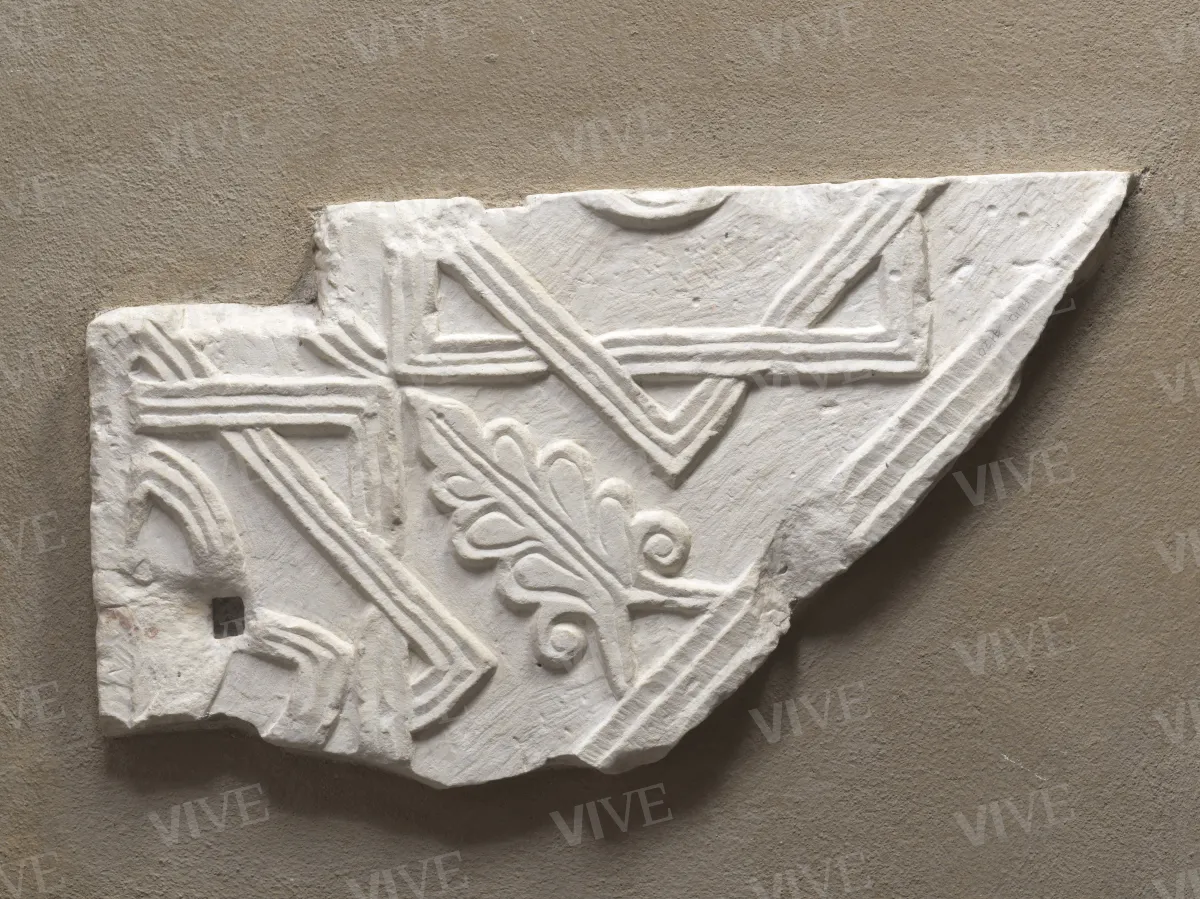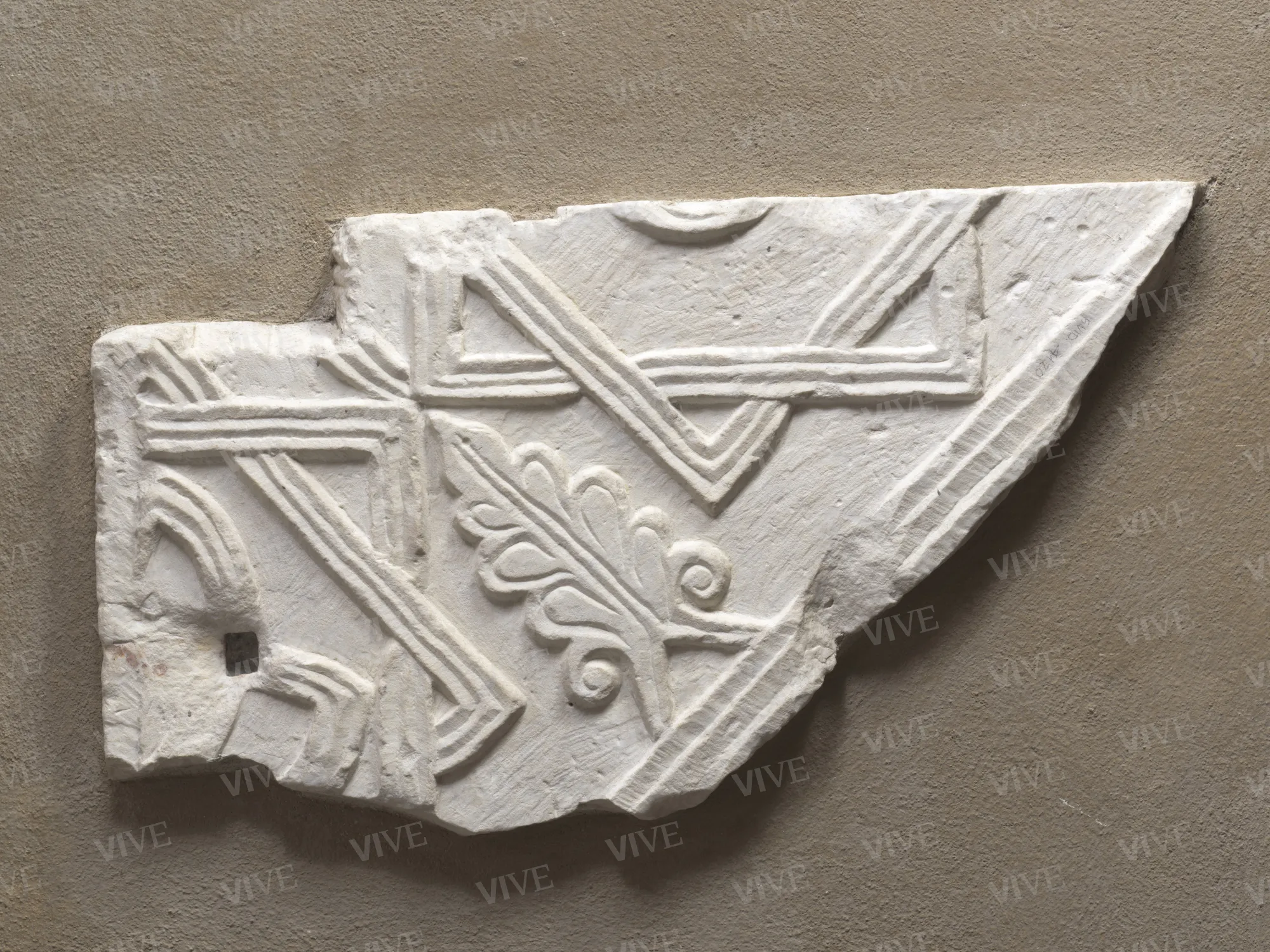Fragment of pluteus with star-shaped quadrilaterals and sapling
Roman milieu First quarter of 9th century
Fragment of marble pluteus adorned with a double quadrilateral motif of two-lined wicker ribbon motifs intersecting to form a star and tangent, filled with a coil of interlaced two-lined wicker ribbon motifs and a circular motif, possibly a rotating rosette, separated by a stylized sapling with a bifurcated trunk, cauliculi, and profiled podded leaves.
Fragment of marble pluteus adorned with a double quadrilateral motif of two-lined wicker ribbon motifs intersecting to form a star and tangent, filled with a coil of interlaced two-lined wicker ribbon motifs and a circular motif, possibly a rotating rosette, separated by a stylized sapling with a bifurcated trunk, cauliculi, and profiled podded leaves.
Details of work
Catalog entry
The marble fragment of a pluteus, cropped to the shape of a wedge to be repurposed, is decorated with a double motif of two-lined wicker ribbon quadrilaterals touching each other and intersecting to form a star, bordered by a now severely abraded sawtooth frame, a short section of which is preserved at the base of the artifact. Set on the cornice is a stylized sapling, characterized by a bifurcated trunk with profiled, inclined cauliculi and podded leaves on either side of a double-parallel incised stem. The tip of the sapling converges at the point at which the two lozenge forms meet, from which proceeds the base of a two-lined ribbon motif, probably a palmette or lily. The quadrilaterals with star are likely filled on the left with an interlacing entwined mass with interrupted angle and on the right a circular motif resembling a rotating rosette.
The ornamental motifs were common from early medieval Roman sculptural production. The eight-pointed star harks back to the Eastern tradition, following models from the Justinian period found in Rome in the sixth century at San Clemente and, later, in the presbyterial enclosure constructed during the papacy of Gregory III (731–741) in Saint Peter’s in the Vatican (Russo 1985; Guiglia Guidobaldi 2002; Ballardini 2008). More common in the Roman context, from the late eighth century on, is the association of the eight-pointed star with the scroll cross, profiled or decorated with an interlacing motif, found in one of its earliest forms in the fragmentary pluteus from Sant’Ippolito all’Isola Sacra near the ancient port (Macchiarella 1976, fig. 280), commissioned by Leo III (795–816). In our fragment, the absence of the cross and fleur-de-lis apices in the eight-pointed star is closer to the early Christian and Petrine prototype, represented by the pluteus in the Vatican Grottoes (Ballardini 2008, fig. 21) with a stylized flower in the center of intersecting star-shaped squares, an iconographic styleme referencing the Christ–rose, an image of the perfection of creation (Elbern 1983).
In Santa Sabina (Trinci Cecchelli 1976, fig. 232), on an older pluteus probably repurposed in a building site dating to the papacy of Eugene II (824–827; on the dating of early medieval pieces from Santa Sabina see Roth-Rubi 2015), the star motif encloses a rare cross motif formed by five interwoven circles of two-lined wicker ribbon, flanked by Gordian knots with ogival and fleur-de-lis eyelets, as well as palmettes and saplings, external to and touching the frame, not unlike the current artifact. The dating proposed, based on stylistic considerations, for the Santa Sabina pluteus (Trinci Cecchelli 1976) to the second half of the eighth century—which is earlier than the end of the century formulated by Federico Mazzanti, who found the slabs in the Aventine church (Mazzanti 1986; Gianandrea 2011)—should be deferred for our fragment to at least the papacy of Leo III (795–816) in light of other typological and formal findings.
The sawtooth frame (Kautzsch 1939; Seminario 1976) which appears along with the two-lined wicker ribbon motif (Casartelli Novelli 1976; Roperti 2007) belongs to the continuity of intent and work that has been identified in the sites that were active during the papacies of Leo III (795–816) and Paschal I (817–824) (Melucco Vaccaro 1999; Ballardini 2008). The stylized sapling with bifurcated trunk and engraved leaves, the emblem of the tree of life, is also more likely formally related to the similar motif found on the Santa Sabina pluteus (Trinci Cecchelli 1976, fig. 232), which can be compared with the saplings on later slabs (Trinci Cecchelli 1976, figs. 234–236, 238; Betti 2017) attributed to the enclosure of Eugene II (824–827).
In the pluteus fragment that was repurposed and walled upside down in Santa Maria in Trastevere (Kautzsch 1939, fig. 5), dating to the refurbishing of the basilica’s pergula commissioned by Gregory IV (827–844) (Bull-Simonsen 2001; Pittaccio 2013), we have a reoccurrence of the double motif of the eight-pointed star, separated here by palmettes instead of saplings, according to a pattern that Kautzsch accurately dates to the prototype of the oldest of the Santa Sabina slabs.
Everything seems to point to the first quarter of the ninth century—that is, from initial attempts to recover early Christian models within the new typological repertoire of the Leonian and Carolingian temperament up to a consolidation of techniques and iconographies in a now mature production such as that of the Esquiline.
Valentina Brancone
Entry published on 12 February 2025
State of conservation
Mediocre. Cropped to a wedge shape and chipped, with cavities and holes.
Restorations and analyses
1999 (cleaning).
Provenance
Unknown. Found during excavations for the Palazzetto, as part of demolition carried out in the area for the relocation of the Palazzetto di Venezia (1910–1914).
Sources and documents
Rome, Archivio del Museo del Palazzo di Venezia, inventorying the sculptures of the lower and upper loggias (manuscript inventory edited by Maria Vittoria Brugnoli, 1973);
Seminario sulla tecnica e il linguaggio della scultura a Roma tra VIII e IX secolo, in Atti del simposio su Roma e l'Età carolingia, coordinated by Avagnina Maria Elisa, Istituto di Archeologia e Storia dell'arte, Rome 1976.
References
Mazzanti Federico, La scultura ornamentale romana nei bassi tempi, in «Archivio Storico dell’Arte», s. II, II, 1896, pp. 33-57, 161-187;
Kautzsch Rudolf, Die römische Schmuckkunst in Stein vom 6. bis zum 10 Jahrhundert, in «Römisches Jahrbuch für Kunstgeschichte», III, 1939, pp. 3-73;
Trinci Cecchelli Margherita, La Diocesi di Roma, t. IV, La I regione ecclesiastica, Corpus della scultura altomedievale, VII, Spoleto 1976;
Casartelli Novelli Silvana, L’intreccio geometrico del IX secolo, scultura delle cattedrali riformate e «forma simbolica» della rinascenza carolingia, in Roma e l’età carolingia. Atti delle giornate di studio (Roma, 3-8 maggio 1976), a cura dell’Istituto di Storia dell’Arte dell’Università di Roma, Roma 1976, pp. 103-113;
Macchiarella Gianclaudio, Note sulla scultura in marmo a Roma tra VIII e IX secolo, in Istituto di Storia dell’Arte dell’Università di Roma (a cura di), Roma e l’età carolingia. Atti delle giornate di studio (Roma, 3-8 maggio 1976), Roma 1976, pp. 289-299;
Macchiarella Gianclaudio et al., Seminario sulla tecnica e il linguaggio della scultura a Roma tra VIII e IX secolo, in Roma e l’età carolingia. Atti delle giornate di studio (Roma, 3-8 maggio 1976), a cura dell’Istituto di Storia dell’Arte dell’Università di Roma, Roma 1976, pp. 267-288;
Elbern Victor Heinrich, Bildstruktur-Sinnzeichen-Bildaussage. Zusammenfassende Studie zur unfigürlichen Ikonographie im frühen Mittelalter, in «Arte medievale», 1, 1983, pp. 17-37;
Russo Eugenio, La recinzione del presbiterio di San Pietro in Vaticano dal VI all’VIII secolo, in «Atti della Pontificia Accademia Romana di Archeologia. Rendiconti», 55-56 (1982-1983/1983-1984), 1985, pp. 3-33;
Melucco Vaccaro Alessandra, Le officine marmorarie romane nei secoli VII-IX. Tradizione e apporti, in Cadei Antonio et al. (a cura di), Arte d’Occidente. Temi e metodi. Studi in onore di Angiola Maria Romanini, I, Roma 1999, pp. 299-308;
Bull-Simonsen Einaudi Karin, L’arredo liturgico medievale in Santa Maria in Trastevere, in de Blaauw Sible (a cura di), Arredi di culto e disposizioni liturgiche a Roma da Costantino a Sisto IV. Atti del Colloquio internazionale (Roma, 3-4 dicembre 1999), Roma 2001, pp. 81-99;
Guiglia Guidobaldi Alessandra, La scultura di arredo liturgico nelle chiese di Roma: il momento bizantino, in Guidobaldi Federico, Guiglia Guidobaldi Alessandra (a cura di), Ecclesiae urbis. Atti del Congresso internazionale di studi sulle chiese di Roma (IV-X secolo) (Roma, 4-10 settembre 2000), III, Città del Vaticano 2002, pp. 1479-1524;
Latini Massimo, Sculture altomedievali inedite del Museo Nazionale del Palazzo di Venezia in Roma, in «Rivista dell’Istituto Nazionale d’Archeologia e Storia dell’Arte», 57, 2003, pp. 113-152;
Roperti Antonella, Note sulla scultura, in Bonacasa Carra Rosa Maria, Vitale Emma (a cura di), La cristianizzazione in Italia tra Tardoantico ed Altomedioevo. Atti del IX Congresso Nazionale di Archeologia cristiana (Agrigento, 20-25 novembre 2004), vol. I, Palermo 2007, pp. 411-420;
Ballardini Antonella, Scultura per l’arredo liturgico nella Roma di Pasquale I: tra modelli paleocristiani e Flechtwerk, in Quintavalle Arturo Carlo (a cura di), Medioevo: arte e storia, X Convegno internazionale di studi (Pavia, 18-22 settembre 2007), Milano-Parma 2008, pp. 225-246;
Latini Massimo, in Barberini Maria Giulia (a cura di), Tracce di pietra. La collezione dei marmi di Palazzo Venezia, Roma 2008, pp. 175-194, schede 1-29;
Gianandrea Manuela, Note sul perduto arredo liturgico di Santa Sabina all’Aventino nel corso del Medioevo, in «Rivista dell’Istituto Nazionale d’Archeologia e Storia dell’Arte», s. III, 66, 2011, pp. 151-164;
Pittaccio Stefano, Santa Maria in Trastevere, aspetti inediti di un progetto all’antica. Origini e formazione, in Cantatore Flavia et al. (a cura di), Giornate di studio in onore di Arnaldo Bruschi (Roma, 5-7 maggio 2011), I, Roma 2013, pp. 13-25;
Roth-Rubi Katrin (in collaborazione con Sennhauser Rudolph), Die frühe Marmorskulptur aus dem Kloster St. Johann in Müstair, Ostfildern 2015;
Betti Fabio, L’arredo liturgico della Basilica di Santa Sabina al tempo di papa Eugenio II: dalla scoperta ai restauri storici (1894, 1918, 1936), in «Arte medievale», 7, 2017, pp. 31-52.












